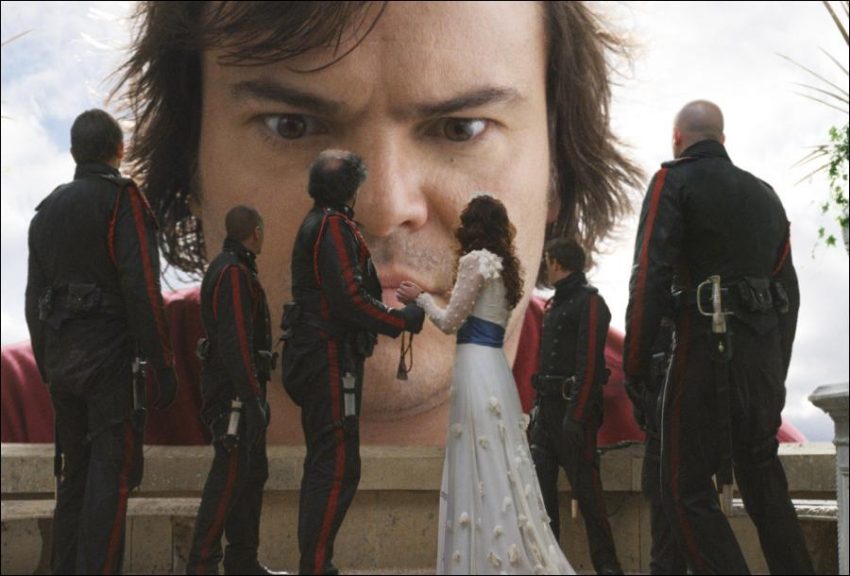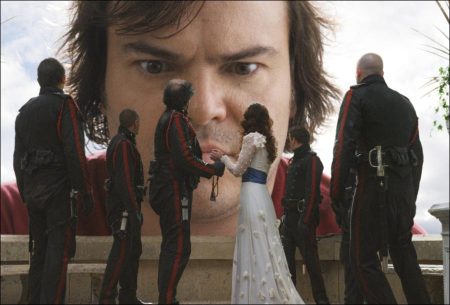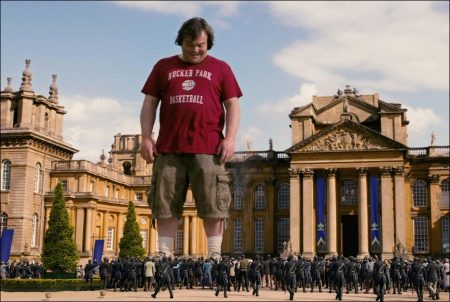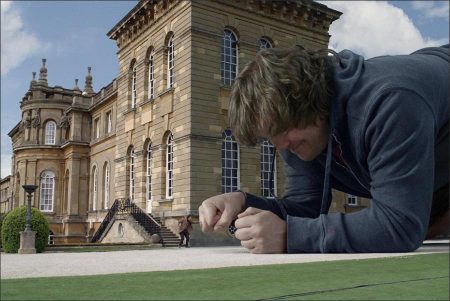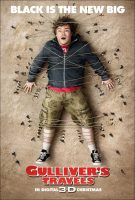All About Gulliver’s Travels
It is Gulliver’s attempts to trick travel editor Darcy that sets in motion his epic adventure among the Lilliputians. He cons Darcy, for whom he has unrequited romantic feelings, into a choice writing assignment that takes him to the Bermuda Triangle and beyond – way beyond – to Lilliput. When Gulliver washes ashore this strange new world, among the first he meets is General Edward Edwardian, the commander of the Lilliput army.
Edward’s distrust of the gargantuan creature – Gulliver – that has suddenly appeared in Lilliput, as well as the general’s ambitions, leads him to take Gulliver prisoner. But his tactics backfire when Gulliver becomes the new (Really) Big Man on Campus, and takes Edward’s place as commander. “When Gulliver lands itself on Edward’s shore, Edward’s world is thrown into turmoil, and he goes to the dark side,” says Chris O’Dowd. “Edward is incredibly pompous and full of ceremony, and believes that things must have a certain order. He is very disappointed that everyone gets in line with Gulliver.”
While Edward is known across the land for his military exploits, another Lilliputian, Horatio, is a commoner who yearns for something more. But when Horatio befriends Gulliver – they first bond over hay and sewer water, the only things to eat during their temporary stint in prison – Horatio’s luck begins to change. As Gulliver becomes a hero to the Lilliputians, the newly emboldened giant takes Horatio under his wing and helps him woo the once unattainable Princess Mary, who is “engaged” to Edward. “The only problem, of course, is that Gulliver is full of it,” says Black. Adds Segel, who employed a British accent for the role: “Like Gulliver, Horatio learns the hard way that the best move, in life and romance, is to be yourself.”
The object of both Horatio’s and Edward’s affections, Princess Mary, spends most of her days preparing for and being kidnapped by the enemy Blefuscians. The once-weekly occurrence isn’t exactly what the princess wants to be doing with her entire life; moreover, the perfunctory courtship of pre-destined paramour Edward is boring her to death. So the romantic attentions of the intriguing Horatio are at least something new for the princess.
Emily Blunt, best known for portraying hard-edged characters, like the intensely neurotic executive assistant in “The Devil Wears Prada” and a biohazard/crime scene clean-up specialist in “Sunshine Cleaning,” relished the chance to take on what she calls her most “girly” role to date. “It was time to play someone sweet and innocent for once,” says Blunt, who also appreciated the theme of changes and modernization that run through the story. “Gulliver has an edgy, modern sensibility that Jack really brings to life,” she says. “His Gulliver comes to our little world and gets everyone riled up, enabling them to see the world in a new way.”
The princess’ father is King Theodore, Lilliput’s gruff but fair-minded ruler. Like his commander, General Edward, Theodore is initially wary of Lilliput’s new arrival. “The king is threatened by this, well, alien, who’s come into his life and the lives of his subjects,” says renowned Scottish comic actor Billy Connolly, who takes on the role. “But Theodore soon realizes he has to deal with Gulliver, and he does.”
King Theodore’s wife, Queen Isabelle, is a rather staid presence. But when Gulliver starts modernizing Lilliput, she, too, undergoes changes. “Gulliver loosens her up quite a bit,” says Tate, who appears in Twentieth Century Fox’s upcoming comedy “Monte Carlo.” “He even reignites the spark in her marriage to Theodore.”
In a world full of surprises, perhaps the biggest shock comes with the appearance of a robot designed and built by the ever-scheming General Edward to once and for all eliminate Gulliver. Inspired by a magazine article found on Gulliver’s wrecked ship, Edward devises an intricate assembly of gears and pulleys that “drive” the robot’s motion. (The mechanical beast, piloted by Edward inside its head, even gives Gulliver a giant wedgie.)
Noted visual effects house hy*drau”lx (“2012”) worked closely with Rob Letterman on the CG ‘bot design and execution. (Also making critical contributions to the world of Lilliput was premier visual effects house WETA Digital, which won Oscars for its groundbreaking work on “Avatar,” “The Lord of the Rings” trilogy and “King Kong”.) Here, too, the robot design married the modern with the less-so. “Part of the original concept of the robot was to have its contemporary design accompany a Victorian-era technology,” says hy*drau”lx’s Erik Liles. “This gave rise to the more mechanical aspects of the robot’s locomotion – its gears and pulleys system. Initially, we were also going to use steam power, like an old locomotive engine, to drive the robot, but that was scrapped due to the visual clutter it caused. Instead, we opted for a cleaner, more refined look.”
The visual effects wizards at hy*drau”lx didn’t make things easy for themselves. The robot begins life as a miniature, trashcan-shaped device that transforms to the gargantuan, exaggerated and cartoonish heap that battles Gulliver. Since the filmmakers continued to sort through these challenges and put the final CG touches on their creation well into the post-production process, during production Jack Black found himself battling a junior-sized version – a robot suit worn by a stuntman. This allowed Black to interact with the robot during filming, helping both the actor and visual effects team map out the no-holds-barred contest we see onscreen.
The entire cast – robot included – appreciated not only the talents of Jack Black the Actor, but the work ethic and dedication to the project from Jack Black, the Executive Producer. The latter was a stern taskmaster for actor Black during some of the film’s action set pieces. For a scene where Gulliver singlehandedly battles the Blefuscian armada, high-speed cameras captured Black, who stripped to the waist and jiggled his bare torso to simulate the effects of hundreds of miniature cannonballs slamming into Gulliver’s stomach, making waves in his flesh. If that wasn’t enough, Black was also tied down to a beach, dragged around in a cumbersome pulley, blasted with rain, and rocked and rolled on a boat atop a giant gimbal.
Even when things were relatively calm in Lilliput, and Black wasn’t before the cameras, he was on set everyday to feed his lines to his cast mates who were acting to Gulliver’s eye line. With over half the film set against enormous green screens situated on massive soundstages, Black’s line readings were invaluable to the other actors.
Also essential in assisting the actors, as well as creating a cohesive and relatable world, was a groundbreaking camera known as the DualMoCo (the “MoCo” is for motion control), which was used extensively for the first time on “Gulliver’s Travels”. The DualMoCo utilized complex computer technology and synchronized camera cranes to capture, in real time, the bigger-than-life Gulliver and the tiny Lilliputians in the same scene, despite the characters’ enormous height differential. While Black was in one area of the soundstage, performing against a green screen, the actors portraying the Lilliputians would be on another part of the stage, acting “opposite” Black.
Explains Rob Letterman: “I wanted Jack to interact with the other cast members, and for those interactions to feel natural – as if they all really were in the same room. For a comedy, that’s essential.” Adds producer Gregory Goodman: “On screen, you’ll see Jack speaking with a character who’s a tiny fraction of Gulliver’s size. The aim in using the DualMoCo was to make the effect look real and yet like nothing you’ve seen before.”
Much of this action was captured on the massive soundstages at England’s Pinewood Studios, where the production was based. At Pinewood, production designer Gavin Bocquet (“Star Wars – Episodes I-III”) created much of the world of Lilliput. Adhering to the filmmakers’ mandate to mix the fantastical and real, Bocquet largely avoided obvious, oversized sets for the Lilliputians and miniature sets for Gulliver.
The Gulliver: Lilliput size ratio of 22:1 was a key factor in his creative decisions. “I was always considering scale issues, and how the Lilliputians would build for someone so much larger than they were,” confirms Bocquet, who points to Gulliver’s Lilliput beach house / bachelor pad as an example. “Its walls look 120-feet high to the Lilliputians, so we had to visualize how they would build it,” he explains. “If you half-close your eyes, the house will look ‘normal.’ But if you look more closely at the details” – like a super-sized (to the Lilliputians) coffee machine, windows and intricate floor detail –“it’s all been made to look as if they had been built by people three-inches tall. That is a lot of sticks as floorboards!”
“Gulliver’s Travels” also made good use of some of England’s most glorious locations, including Blenheim Palace and the Old Royal Naval College of Greenwich in southeast London – a baroque 17th century architectural masterpiece, and home to a major dance number, choreographed to the classic Edwin Starr hit “War,” which closes the film. With its refrain, “War! Huh, what is it good for? Absolutely nothing!” the song riffs on Jonathan Swift’s anti-war themes. At the same time, says Black, “We made [the song] as rocking as possible while staying true to the world of Lilliput.”
Black pieced together this version of “War,” complete with baroque instruments, with John Kimbrough, and recorded it. (Henry Jackman composed the film’s score.) Much of that recording made it into the final version on screen. The dance number was developed with a core group of 40 dancers, and then it was rehearsed with 250 extras on location in Greenwich, England.
With principal photography wrapped, the filmmakers turned their attention to the extensive post-production work, which included the ambitious visual effects, as well as expert stereography’s creating an immersive 3D experience for moviegoers. Rob Letterman notes that while this technical wizardry is important, “Gulliver’s Travels” is really about characters, relationships and heartfelt emotions. It’s a tricky thing to sell emotion between six-inch-tall character and their new guest – a giant. The effects and 3D are just icing on the cake.”
Gulliver’s Travels (2010)
Directed by: Rob Letterman
Starring: Jack Black, Emily Blunt, Jason Segel, Amanda Peet, Billy Connolly, Chris O’Dowd, Catherine Tate, Stewart Scudamore, Stewart Scudamore, Olly Alexander, David Sterne, T.J. Miller, Emmanuel Quatra
Screenplay by: Joe Stillman, Nick Stoller, Jonathan Swift
Production Design by: Gavin Bocquet
Cinematography by: David Tattersall
Film Editing by: Alan Edward Bell, Maryann Brandon, Nicolas De Toth, Dean Zimmerman
Costume Design by: Sammy Sheldon
Set Decoration by: Richard Roberts
Art Direction by: Robert Cowper, Phil Harvey, Rod McLean, Peter Russell
Music by: Henry Jackman
MPAA Rating: PG for brief rude humor, mild language and action.
Distributed by: 20th Century Fox
Release Date: December 25, 2010
